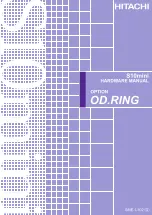
Parallel SCSI Interface Product Manual, Rev. A
101
fer agreement shall remain intact;
b. If a WDTR message fails for any other reason, the prior synchronous data transfer agreement shall
remain intact; or
c. If a WDTR message is not rejected with a MESSAGE REJECT message, a WDTR message shall reset
the synchronous data transfer agreement to asynchronous mode and any protocol option bits (see Sec-
tion 4.3.16) shall be set to zero.
The originating SCSI device (the SCSI device that sends the first of the pair of WDTR messages) sets its trans-
fer width value to the maximum data path width it elects to accommodate. If the responding SCSI device is able
to also accommodate this transfer width, it returns the same value in its WDTR message. If it requires a
smaller transfer width, it substitutes the smaller value in its WDTR message. The successful completion of an
exchange of WDTR messages implies an agreement as shown in Table 39.
Table 39:
WDTR message implied agreement
If there is an unrecoverable parity error on the initial WDTR message (see sections 3.9.2 and 3.9.3) the initiat-
ing SCSI device shall retain its previous data transfer mode. If there is an unexpected bus free on the initial
WDTR message the initiating SCSI device shall retain its previous data transfer mode.
4.3.18.1
Target initiated WDTR negotiation
If the target recognizes that WDTR negotiation is required, it sends a WDTR message to the initiator.
The initiator shall create an attention condition on the last byte of the WDTR message from the target, and the
initiator shall respond with its WDTR message, MESSAGE PARITY ERROR message, or with a MESSAGE
REJECT message.
If an abnormal condition prevents the initiator from responding with a WDTR message or with a MESSAGE
REJECT message, then both SCSI devices shall go to eight-bit data transfer mode for data transfers between
the two SCSI devices.
Following an initiator's responding WDTR message, an implied agreement for wide data transfers operation
shall not be considered to exist until the target leaves the MESSAGE OUT phase, indicating that the target has
accepted the negotiation.
If the target does not support the initiator’s responding Transfer Width Exponent,
the target shall switch to a
Message In phase and the first message shall be a MESSAGE REJECT message. In this case, the implied
agreement shall be considered to be negated and both SCSI devices shall use the eight-bit data transfer mode
for data transfers between the two SCSI devices. Any prior synchronous data transfer agreement shall remain
intact.
If a parity error occurs, the implied agreement shall be reinstated if a retransmission of a subsequent pair of
messages is successfully accomplished. After a device-dependent number of retry attempts (greater than
zero), if the target continues to receive parity errors, it shall terminate the retry activity. This is done by the tar-
Responding SCSI device
WDTR response
Implied agreement
Transfer Width Exponent equal to one
16-bit data
Transfer Width equal to zero
Eight-bit data transfer
MESSAGE REJECT message
The originating SCSI device shall set eight-bit data transfer
Parity error (on responding message)
Eight-bit data transfer
Unexpected bus free (as a result of the
responding message)
Eight-bit data transfer
No response
Eight-bit data transfer
Содержание Ultra 160
Страница 1: ...Parallel SCSI Interface Ultra 160 Ultra 320...
Страница 2: ......
Страница 3: ...Parallel SCSI Interface Ultra 160 Ultra 320...
Страница 6: ...iv Parallel SCSI Interface Product Manual Rev A...
Страница 14: ...xii Parallel SCSI Interface Product Manual Rev A...
Страница 64: ...50 Parallel SCSI Interface Product Manual Rev A...
Страница 144: ...130 Parallel SCSI Interface Product Manual Rev A...
Страница 184: ...170 Parallel SCSI Interface Product Manual Rev A...
Страница 185: ......
















































